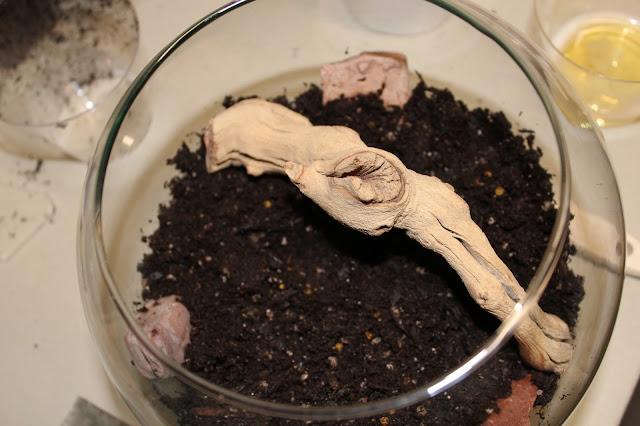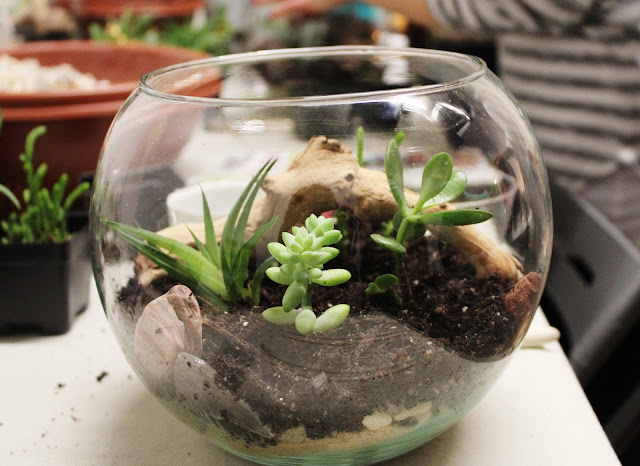Terrarium Basics With The Zen Succulent
7:00 AMI think we've pretty much all seen terrariums and thought, "I could do that!" But then you read about it a little, see all the supplies you need, and manage to kill a succulent or two, and you realize, maybe terrariums aren't for you after all. That's where I was at mentally before I got the chance to learn from an expert in terrarium creation and care: Megan George of Raleigh's own The Zen Succulent. She literally wrote the book on terrarium making (no, really-- it's called Modern Terrarium Studio) and was so kind to share her knowledge with members of Triangle Fashion and Beauty Bloggers and Raleigh Blog Society last week at Ramble Supply Company.
 |
| Jess at Ramble Supply had the place decorated so beautifully to set the mood for a terrarium class. Check their website because she often hosts classes from a variety of different local artisans, so you can make everything from your own soap to wreaths and flower crowns with a group of friends for a fun and creative night out downtown. |
She started off by giving us a few basics. Succulent plants store water in their leaves, so over-watering is the biggest reason people kill them. Here's a great example of your plant telling you to lay off the water:
They also need well-drained soil, so if you are watering too much or leaving them wet for too long, your plants can start looking like the one above. Once a week is a good rule of thumb on watering.
There's no shortage of varieties of succulents that will be at home in an open-air terrarium. And these plants can root almost anywhere, so they are easy to propagate just by pinching off a branch and shoving the broken end into soil. Most of Megan's plants are from her own propagation, but she also likes to buy new varieties from Raleigh's own J & C Greenhouses at the Raleigh Farmer's Market.
Simple Steps To Making Your Own Terrarium
Because it's hard to buy supplies in small quantities, terrarium making is perfect for a group activity so everyone can share. Here is what you'll need and Megan's step by step guide to a basic terrarium that will last for years to come:
1. A Glass Container
Megan buys containers at a discount from places like T. J. Maxx or Marshalls, but her book is full of ideas for out-of-the-box terrarium containers too. For working with your soil and filler, having a paint brush to spread around dirt and some wooden dowels are perfect tools for gently pressing your succulent roots into the soil without manhandling the plant too much. Wooden chopsticks would be a great free alternative the next time you get Chinese take out.
2. Fill with Sand
Fill your container about 10% with regular old playground sand. It's hard to come by a small bag, so again, easiest to share this with a group unless you are making a ton of terrariums. Sand is a great way to promote water drainage in your terrarium because your succulent plants do not like wet roots.
3. Fill with Rocks
Now put a layer of rocks over your sand to fill another 10% of your terrarium. You can buy a bag of rocks at Lowe's or Home Depot, but pet stores are also a great option in the aquarium department. Remember to wash your rocks before putting them in your terrarium (especially if you got them at a garden supply company) because they could have been cleaned with chemicals prior to packaging that might be toxic to your plant. You can use your brush to spread things evenly. Rocks are an extra source of drainage which is why they are so commonly found in terrariums.
4. Sprinkle with Charcoal
A little charcoal goes a long way. A vase this size needs about a gram of charcoal to do the trick. Charcoal helps prevent bugs or pests from wanting to nest in your cute little terrarium biosphere, and acts as a natural "air freshener" in case you watered a little too much and your terrarium starts smelling a little musty. Charcoal for planting can be found in the plant sections at most gardening/home stores.
5. Fill with Soil
The best soil for a terrarium is a fast-draining variety. Don't get your regular garden potting soil variety because it retains moisture. Cactus soil or "quick draining" soil is your best bet. You want about a 2-3" layer of soil spread evenly over your rocks at this stage.
6. Add Some Decor
Now's the time to branch out. You can add natural element like stones or pieces of grapevine wood (seen here), or really think outside of the box and add quirky elements like old toys or plastic animals. This is your little terrarium world -- think of it like a plant aquarium. Personality encouraged.
7. Time for the Plants
There's no real right or wrong, but an easy step for terrarium success is to pick a short, medium, and tall variety of succulent to add height and texture to your vase. A vase this size can hold three or four single plants, but stuffing in more won't give them much room to grow.
The hardest part of terrarium making for me was planting the succulents without breaking the delicate stems and leaves. For best success, use your wooden dowel to dig a little hole. Then put your succulent roots inside this depression and let go. Gently use the dowel to press the soil around the plant and firmly bury the root downwards. If you are holding onto the plant while you do this, or try to push the plant downwards with your hands, you are much more likely to break a part off.
8. Top with Pebbles, Stones, or Rocks if desired. Or don't.
I think it looked good with dirt exposed, but I also liked the rock on top look that I ended up going with:
These are truly just the basics to a lovely, easy to maintain terrarium that will thrive in any spot in your home with good, indirect lighting. Please check out Megan's book, Modern Terrarium Studio if you want to get more creative project ideas, and to learn so much more from the expert about the best plants to choose and troubleshooting their care. It was such an honor to walk away from this class not just with a terrarium that I'm proud of, but understanding how this little biosphere works and how to make my plants live and thrive. She's truly passionate about her work and if you get a chance to take one of her classes, don't miss the opportunity to do so!























0 comments